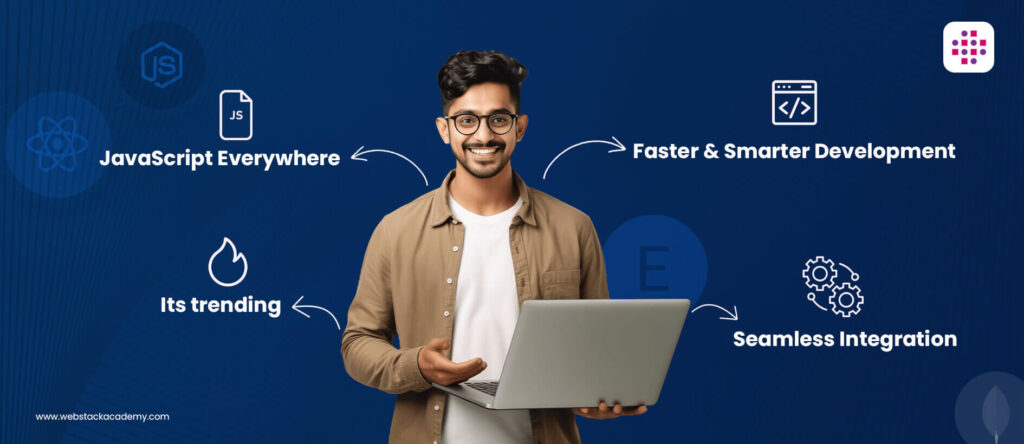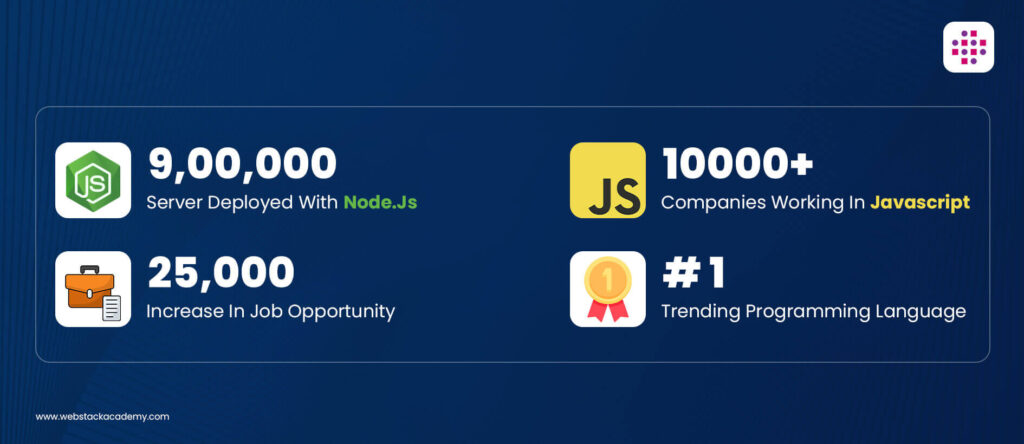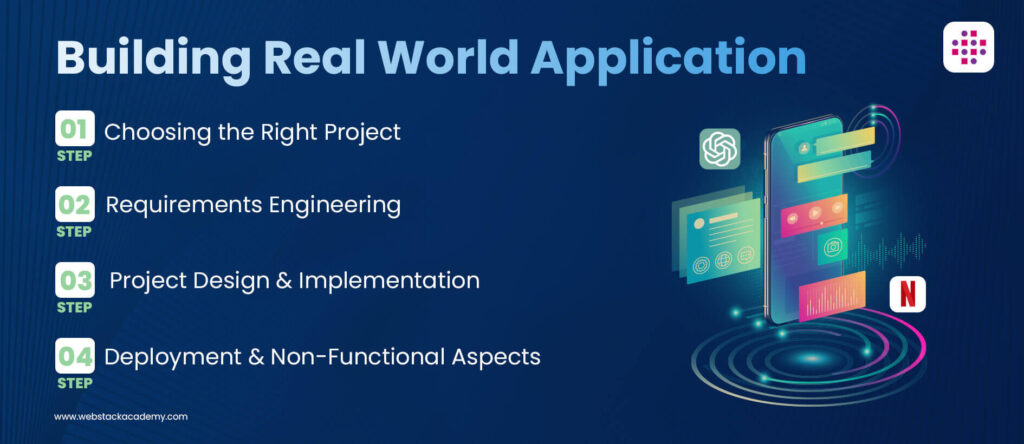Introduction
In the fast-changing field of web development, creative ideas come to life through tools that make it easier to build dynamic and interactive websites. The MERN stack is one of these powerful tools, combining various technologies to help developers create web apps, Full stack MERN project and full stack web development project more easily and effectively.
At its core, the MERN stack relies on JavaScript, a versatile language that works well across different platforms and areas, truly living up to the idea of JavaScript Everywhere.
Let’s delve into the realm of MERN stack development and explore how you can build web development projects using MERN stack.
What is MERN Stack?
A technology stack, commonly referred to as a tech stack, within the realm of web development, represents a fusion of programming languages, software tools, frameworks, libraries, and various other technologies. These elements collaborate harmoniously to construct and sustain a fully functional web application.
These components synergize to deliver the essential functionalities required for the development, deployment, and maintenance of web applications. Traditionally, a typical web technology stack can be categorized into several layers, including Frontend Technologies, Backend Technologies, Databases, and more.
In the ever-evolving landscape of web development, the MERN Stack has emerged as an influential and adaptable framework. It empowers developers to craft dynamic and resilient web applications, including Full Stack MERN projects. Comprising four integral components—MongoDB, Express.js, React.js, and Node.js—the MERN Stack offers a seamless and all-encompassing toolkit, equipping developers with the resources necessary for creating contemporary web solutions.
Components of the MERN Stack
Let us get a brief introduction of each of the components of the MERN stack.
MongoDB
At the heart of the MERN Stack lies MongoDB, a NoSQL database that stores data in a flexible, document-oriented format. It allows developers to adapt and modify data structures without constraints.
Express.js
Serving as the backend web application framework, Express.js simplifies the process of building robust and scalable web development projects and Full Stack MERN project. With its minimalistic design and numerous middleware options, Express.js streamlines the creation of server-side functionalities.
React.js
On the frontend, React.js stands as a renowned JavaScript library for building user interfaces. It facilitates the creation of interactive and responsive UI components, allowing developers to efficiently manage and update user experiences.
Node.js
Powering the server-side scripting, Node.js enables JavaScript to run on the server, providing a fast and scalable environment for handling requests and responses.
Benefits of MERN Stack
There are many benefits of writing a web application using MERN stack some of the include:
- JavaScript Everywhere: Both in Frontend and Backend only programming language (i.e JavaScript) is used. This makes the development process easier.
- Faster and Smarter Development: From writing fewer lines to re-using packages, there are many features that make JavaScript development a breeze.
- Its Trending: Multiple time JavaScript emerged as the most popular language, having broader acceptance among developers
- Seamless Integration: MERN stack has seamless collaboration of its components. Data stored in MongoDB flows through Express.js, which processes and manages server-side logic. React.js then takes over to present this data through dynamic user interfaces.
Career Possibilities with MERN Stack
Learning JavaScript and MERN stack not only improves your technical capability, but also opens up a huge career possibilities. Some of the statistics include:
- 25000% increase in job opportunities, worldwide. Companies find hard to hire talent
- 10000+ Companies are asking to include Node.js as the key skill to hire including top-5 companies
- 9,00,000 Servers deployed with Node.js, Highest growth rate among all technologies
- More than 50% of the companies mention MERN stack is the most difficult skill to hire in the market
In order to leverage these opportunities, skilling and building Full Stack MERN project plays a very important role. Let us dive a bit more into it.
Getting Skilled in MERN Stack
There are a lot of online resources available from where one can learn MERN stack. Most of them are available for free. By using these resources and doing some practice exercises one can get started with MERN Stack.
Let us take a look into key technical features and resources from where you can start learning MERN stack.
Step-1: Getting Skilled in MongoDB
As a fundamental component of the MERN Stack, MongoDB plays a vital role in enabling seamless data storage and retrieval. Its schema-less nature allows developers to adapt and modify data structures as projects evolve.
By mastering MongoDB, you empower yourself to efficiently handle data manipulation, design effective databases, and create applications that scale to meet user demands. For modern day web development projects such scalable and flexible databases play a very important role.
To learn MongoDB following resources can be referred to:
- Official Documentation of MongoDB
MongoDB’s official documentation is a valuable resource for beginners and experienced developers alike. It provides comprehensive guides, tutorials, and examples to help you understand the database’s features and functionality.
- Interactive Tutorials
Online interactive tutorials, such as those available on MongoDB’s website and other learning platforms, allow you to learn by actually working with it. These tutorials guide you through practical scenarios and help you grasp concepts in a hands-on manner.
- Community Resources
Engage with the MongoDB community through forums, discussion boards, and social media groups. These platforms are excellent for seeking advice, sharing experiences, and learning from others in the field.
Step-2: Getting Skilled in Express.js
Express.js, a powerful backend web application framework, serves as a cornerstone in the MERN Stack, facilitating the creation of robust and efficient web development projects. With its versatility and streamlined approach, Express.js empowers developers to create dynamic and robust web applications seamlessly.
Middleware and Routing are fundamental concepts in Express.js that contribute to the construction of web development projects.
Middleware functions handle tasks such as authentication, logging, and error handling. They enhance the functionality of your application by executing specific actions before or after route handling. Routing, on the other hand, allows you to define the behavior of your application based on the incoming requests, enabling you to structure your application’s endpoints effectively.
To learn Express.js, here are some of the useful resources:
- Official Documentation:
Starting with the official documentation is always a smart move. It’s a comprehensive resource that covers everything from installation to advanced topics. Explore the official Express.js documentation at expressjs.com.
The Express.js GitHub repository also has a Wiki that provides supplementary information, tutorials, and examples. It’s a valuable resource to complement the official documentation. Express.js Wiki
- Videos and Debugging:
If you prefer video tutorials, “The Net Ninja” offers an excellent Express.js crash course on YouTube. The series covers routing, middleware, templating engines, and much more.
When you’re stuck or have questions about Express.js, Stack Overflow is a treasure trove of knowledge. Search for Express.js-related questions or ask your own if you encounter challenges.
Step-3: Getting Skilled in React.js
Front-end development is the face of any Web Application. The React.js transforms this facet into a dynamic and user-centric experience. React.js revolutionizes front-end development by breaking user interfaces into modular components.
This approach allows for efficient management and updates of UI elements, leading to smoother performance and user interactions. Its virtual DOM minimizes rendering overhead, ensuring that only necessary updates are made to enhance overall speed and responsiveness. Exploring React’s component-based architecture, state management, and the integration of third-party libraries will pave the way to becoming a proficient front-end developer.
By diving into web development projects, experimenting, and engaging in continuous learning, you’ll unlock the ability to craft dynamic and engaging user interfaces that captivate users and enhance their digital experiences.
To learn React.js, here are some of the useful resources:
- Books and Online Courses:
React Up and Running by Stoyan Stefanov, this book is an excellent resource for beginners. It provides a step-by-step guide to building React applications and covers best practices along the way. You can find it on platforms like Amazon or O’Reilly.
For visual learners, Traversy Media offers an excellent React.js crash course on YouTube. It covers React fundamentals, components, state, props, and more. React JS Crash Course – YouTube
- React GitHub:
For those interested in exploring React’s source code and contributing to the project, visit React’s GitHub repository. You can find issues to work on, browse the codebase, and learn from the code written by React’s maintainers.
Egghead.io offers a range of high-quality React courses, including both free and paid content. These courses cover various topics, from React fundamentals to advanced state management with libraries like Redux.
Becoming proficient in React.js is an exciting journey, and the resources mentioned above can help you acquire the skills and knowledge you need.
Step-4: Getting Skilled with Node.js
Node.js revolutionizes server-side development within the MERN Stack by utilizing a non-blocking, event-driven architecture. This approach enables developers to create highly scalable and lightweight web applications that can handle a multitude of concurrent connections.
Node.js leverages JavaScript, providing a unified language for both frontend and backend development, fostering code consistency and collaboration. Node.js thrives on event-driven programming and asynchronous I/O, enabling it to handle numerous simultaneous connections without blocking the execution of other tasks.
This architecture enhances the scalability and performance of web applications by efficiently managing input-output operations, making Node.js well-suited for building real-time applications and APIs.
To learn Node.js, here are some of the userful resources:
- Books and Online Courses:
React Up and Running by Stoyan Stefanov, this book is an excellent resource for beginners. It provides a step-by-step guide to building React applications and covers best practices along the way. You can find it on platforms like Amazon or O’Reilly.
For visual learners, Traversy Media offers an excellent React.js crash course on YouTube. It covers React fundamentals, components, state, props, and more. React JS Crash Course – YouTube
- React GitHub:
For those interested in exploring React’s source code and contributing to the project, visit React’s GitHub repository. You can find issues to work on, browse the codebase, and learn from the code written by React’s maintainers.
Egghead.io offers a range of high-quality React courses, including both free and paid content. These courses cover various topics, from React fundamentals to advanced state management with libraries like Redux.
Becoming proficient in React.js is an exciting journey, and the resources mentioned above can help you acquire the skills and knowledge you need.
WSA’s Skilling Approach
In alignment with the skill-building steps mentioned above, WSA Online MERN Stack Developer Course with Placement is well structured to derive learner outcomes. Our Online Course is delivered using our Immersive delivery model, as a combination of Live Virtual Classes and Structured Interventions.
Here is a video which explains about our skilling approach:
Building Real-World Web Development Projects with MERN Stack
In the ever-evolving landscape of web development, hands-on experience is the key to mastery. While tutorials and courses provide essential knowledge, they can only take you so far. Building and showcasing real-world full stack web development project and Full Stack MERN Project plays a very important role in your career advancement.
Compared to just doing courses, implementing and showcasing project output has got the following benefits:
- Applied Learning: Real-world projects offer the opportunity to apply what you’ve learned in tutorials and courses.
- Skill Development: Building projects helps you hone your technical skills.
- Problem Solving: Real-world projects often come with complex problems to solve. This challenges your problem-solving abilities, which are crucial for a successful career in web development.
- Portfolio Enhancement: A portfolio of real-world projects is a powerful asset when seeking employment or freelance opportunities. It showcases your abilities and proves your capability to deliver results.
Step-1: Choosing the Right Project
Choosing the right project is the most important step. Whether you’re a beginner eager to gain experience or an experienced coder seeking a new challenge, selecting a project that aligns with your interests and learning goals is crucial.
Following are some of the questions to ask before selecting a project:
- What topics or problems genuinely excite me?
- Are there hobbies or activities I’m passionate about?
- Do I have a strong interest in a particular technology or domain?
- Am I passionate about solving a real-world problem which has an impact?
There are ample resources that are available online to choose a project, here is the list of projects from WSA which you can give a try. These projects are well defined in terms of industry-use cases and learner’s goals.
Step-2: Requirements Engineering
Once you’ve selected a full stack web development project and Full Stack MERN Project to undertake, the next critical step involves dedicating substantial time to comprehend customer requirements and engineer them effectively. It’s imperative to translate customer needs into technically feasible tasks.
The Software Development Life Cycle (SDLC) serves as a well-structured framework that delineates the stages and procedures integral to the design, development, testing, and maintenance of software applications. This framework should be diligently employed throughout the project, particularly during the Requirement Engineering phase.
Through meticulous requirement analysis, the project scope becomes well-defined and is documented comprehensively. This clarity is instrumental in establishing attainable project objectives, realistic timelines, and budgetary constraints, ultimately serving as a safeguard against scope creep and budget excesses.
Crafting an accurate and high-quality Software Requirements Specification (SRS) assumes a pivotal role in ensuring the success of your Full Stack MERN project. Beyond the realm of requirement gathering, the SDLC methodology aids in risk mitigation, efficient allocation of resources, and cost-effective development, all contributing to the project’s overall efficiency and effectiveness.
Step-3: Project Design & Implementation
Once you come up with a SRS, the project moves to the design & implementation phase. Following approach to be followed during Design & Implementation.
- Choose a Tech Stack: Select the programming languages, frameworks, and tools best suited for your project. Consider factors like compatibility, community support, and your own familiarity with the technologies. In our case it will be MERN based JavaScript stack.
- HLD and LLD: Based on the SRS, the design artifacts need to be created in terms of High Level Design (HLD) and Low Level Design (LLD). Create wireframes and design mockups for the user interface (UI) if applicable. Plan the application’s architecture and data models.
- Coding Backend and Frontend: Once you start coding, develop the server-side logic, APIs, and databases. Implement user authentication and any required security measures. Followed by backend Design and build the user interface (UI) based on your wireframes. Integrate the frontend with the backend through API calls.
- Integration and Testing: Once the front-end and back-end is integrated, they need to be integrated and tested. You need to perform unit testing, integration testing, and user testing. Identify and fix any bugs or issues.
Step-4: Deployment and Non-Functional Aspects
Bringing your project to life involves more than just coding. Consider aspects like:
- User Experience (UX) Design: Prioritize creating a seamless and enjoyable user experience. This involves designing user interfaces (UI) that are intuitive, visually appealing, and easy to navigate.
- Documentation: Document your code, APIs, and system architecture comprehensively. Well-documented code and project resources make it easier for your team members to collaborate and maintain the project in the future.
- Code Reviews: Conduct regular code reviews within your development team to catch coding errors, enforce coding standards, and share knowledge.
- Scalability: These platforms often offer scalable hosting solutions. As your full stack web development project attracts more users, the platform can automatically allocate additional resources to accommodate increased traffic.
- Ease of Use: Heroku and Netlify provide user-friendly interfaces that streamline deployment. With a few clicks or simple command-line commands, you can get your project up and running.
In summary, implementation goes beyond coding and involves requirement understanding, design, testing, documentation, and collaborations.
Deployment on platforms like Heroku and Netlify simplifies the process, making your project accessible to the world and allowing you to demonstrate your skills effectively. These combined efforts ensure that your Full Stack MERN project is not just functional but also well-received and impactful.
Conclusion
The MERN stack is currently a trending technology, offering numerous career opportunities. It empowers developers to create scalable and lightweight full stack web development project with sleek user interfaces.
To embark on a journey with the MERN stack, it’s essential to acquire the necessary skills. Understanding the benefits of each stack component and utilizing appropriate resources is crucial, as highlighted in this post.
After acquiring the skills, the next step is to implement and showcase your abilities through real-world full stack web development project. This practical experience is invaluable in establishing your expertise. Employing frameworks like SDLC (Software Development Life Cycle) is vital for efficiently managing full stack web development projects, ensuring they meet customer requirements from inception to launch.
Aspiring web developers who follow this two-step approach, first skilling themselves and then demonstrating their skills through Full Stack MERN project , are well-positioned for a successful career that can reach new heights in the ever-evolving world of web development.
| SN | Related Blogs | Links |
|---|---|---|
| 1 | Cloud Computing Paradigm – the Third Wave! | Click Here |
| 2 | Top 5 Reasons to Choose JavaScript over Java for Web Development | Click Here |
| 3 | Top 10 Jargons Any Web Developer Should Know | Click Here |
People Also Ask(PAA)
While some familiarity with web development basics can be helpful, MERN Stack projects cater to various skill levels. You can start with simpler projects and gradually move to more complex ones.
MERN Stack enables a wide range of projects, from e-commerce platforms and social networking sites to interactive dashboards and blogging platforms. Your imagination is the limit.
MERN Stack is highly sought after by employers due to its versatility. Completing projects showcases your proficiency, making you an attractive candidate for positions ranging from front-end to full-stack developer roles.






